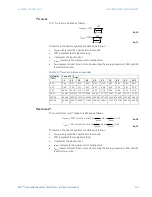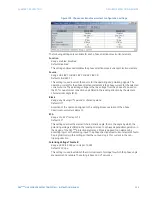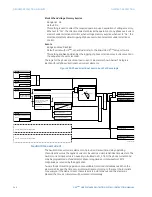
226
D90
PLUS
LINE DISTANCE PROTECTION SYSTEM – INSTRUCTION MANUAL
GROUPED PROTECTION ELEMENTS
CHAPTER 7: PROTECTION
The maximum error of the phase overcurrent elements is less than 2%. A safety factor of
1.25 should be used to account for relay errors and system impedance uncertainty.
If CT saturation is an issue—such as close to a generation where long lasting DC
components are likely to saturate the CTs—it should be noted that the instantaneous
overcurrent elements require 1.33 cycles of data to operate for a multiple of pickup of 1.01.
For higher multiples of pickup, the relation between the multiple of pickup and the amount
of data required for operation before complete CT saturation is approximately linear. For
example, for a multiple of pickup of 4, approximately 1.33 / 4 = 0.332 of a power cycle is
required by the phase instantaneous overcurrent element to operate. The above
information should not be confused with the operating time, which includes some inherent
delays such as a trip rated output contact.
Current elements
The current element settings are described in this section.
Overview of time overcurrent curves
The inverse time overcurrent curves used by the time overcurrent elements are the IEEE,
IEC, GE Type IAC, and I
2
t standard curve shapes. This allows for simplified coordination with
downstream devices. If however, none of these curve shapes is adequate, FlexCurves™
may be used to customize the inverse time curve characteristics. The definite time curve is
also an option that may be appropriate if only simple protection is required.
The following overcurrent curve types are available.
•
IEEE Extremely Inverse.
•
IEEE Very Inverse.
•
IEEE Moderately Inverse.
•
IEC Curve A (BS142).
•
IEC Curve B (BS142).
•
IEC Curve C (BS142).
•
IAC Extremely Inverse.
•
IAC Very Inverse.
•
IAC Inverse.
•
IAC Short Inverse.
•
I
2
t.
•
FlexCurves™ A, B, C, and D.
•
Recloser curves.
•
Definite Time.
A multiplier (time dial) setting allows selection of a multiple of the base curve shape (where
the time dial multiplier = 1) with the curve shape setting. Unlike the electromechanical time
dial equivalent, operate times are directly proportional to the time multiplier setting value.
For example, all times for a multiplier of 10 are 10 times the multiplier 1 or base curve
values. Setting the multiplier to zero results in an instantaneous response to all current
levels above pickup.
Time overcurrent time calculations are made with an internal energy capacity memory
variable. When this variable indicates that the energy capacity has reached 100%, a time
overcurrent element will operate. If less than 100% energy capacity is accumulated in this
variable and the current falls below the dropout threshold of 97 to 98% of the pickup value,
the variable must be reduced. Two methods of this resetting operation are available:
instantaneous and timed. The instantaneous method is intended for applications with
















































